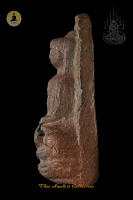History of the Making of Phra Rod Pim Yai BE2518
Wat Mahawan, Lamphun Province – Consecrated in India
Background & Purpose of Creation
The Phra Rod Pim Yai BE2518 is a sacred Buddha amulet modeled after the ancient Phra Rod, one of the Benjapakee (Five Grand Amulets of Thailand) and the most revered amulet from the Lamphun region. This batch was created to revive the sacred legacy of the Phra Rod from the Dvaravati period, honor Buddhist heritage, promote Dhamma practice, and provide a sacred object for spiritual protection and merit-making.
Wat Mahawan, Lamphun Province, the original temple where Phra Rod amulets were historically discovered, led this project to ensure authenticity and sacred energy.
Consecration Ceremony & Blessing Rituals
The Phra Rod Pim Yai BE2518 underwent an elaborate, multi-stage consecration ceremony in both Thailand and India, linking its spiritual power directly to the origins of Buddhism.
First Blessing in Thailand – Wat Mahawan, Lamphun
The initial consecration took place at Wat Mahawan, a temple closely connected to the original Phra Rod lineage. Participating masters included Luang Pu Toh of Wat Pradoochimplee, Archan Churm, a highly respected meditation master, and other renowned monks from various temples. The ceremony incorporated traditional Buddhist chanting, deep meditation, and sacred mantras to infuse the amulet with spiritual potency.
Final Consecration in India – Sacred Buddhist Sites
The amulets were then brought to India for final blessing rituals at several of Buddhism’s holiest pilgrimage sites, including Bodh Gaya (the site of the Buddha’s enlightenment), Sarnath (where the Buddha delivered his first sermon), and Kushinagar (where the Buddha entered Parinirvana). Senior monks from Thailand and India performed sacred ceremonies to connect the Phra Rod Pim Yai with the spiritual essence of Buddhism’s origins. The final consecration at Bodh Gaya allowed the amulet to absorb the sacred vibrations of the Maha Bodhi Tree, making it a profoundly powerful Buddhist artifact.
Physical Characteristics & Sacred Materials
The Phra Rod Pim Yai BE2518 was carefully crafted from sacred powder (Nur Phong) composed of ancient Phra Rod fragments collected from historic Lamphun sites, sacred soil from Bodh Gaya, powder from old Buddha statues, and temple relics from Thailand and India.
Its design follows the large Pim Yai style, closely mirroring the original Phra Rod of the Dvaravati period. The front depicts the Buddha seated in meditation beneath an aura of spiritual authority, while the back features sacred Yant inscriptions and blessing marks to strengthen its spiritual influence. The surface bears a naturally aged texture, reflecting its authenticity and ceremonial consecration.
Spiritual Power & Benefits
Due to its powerful consecration and the involvement of great meditation masters, this amulet is revered for supreme protection against harm (Klaew Klad), enhancement of loving-kindness and charisma (Metta Maha Niyom), attraction of wealth and prosperity, strengthening of meditation and spiritual insight, and providing the wisdom and resilience to overcome life’s challenges.
Rarity & Collectibility
Authentic Phra Rod Pim Yai BE2518 amulets are scarce and highly prized among collectors. Its connection to Luang Pu Toh and the consecration in India, especially at Bodh Gaya, makes it one of the most historically significant and spiritually potent amulets of the late 20th century. Collectors and devotees alike value it for its link to the ancient Phra Rod and its direct association with the holiest sites in Buddhism.
Conclusion
The Phra Rod Pim Yai BE2518, created by Wat Mahawan, Lamphun, and consecrated both in Thailand and India, stands as a masterpiece of sacred craftsmanship. With blessings from Luang Pu Toh, Archan Churm, and other revered monks, combined with the spiritual essence of Bodh Gaya, it is among the most significant Buddhist artifacts of its era—ideal for those seeking protection, prosperity, wisdom, and a deep spiritual connection.

%20Wat%20Pradoochimplee,%20Archan%20Churm,%20etc%E2%80%A6%20joined%20the%20consecration%20in%20India.png)



